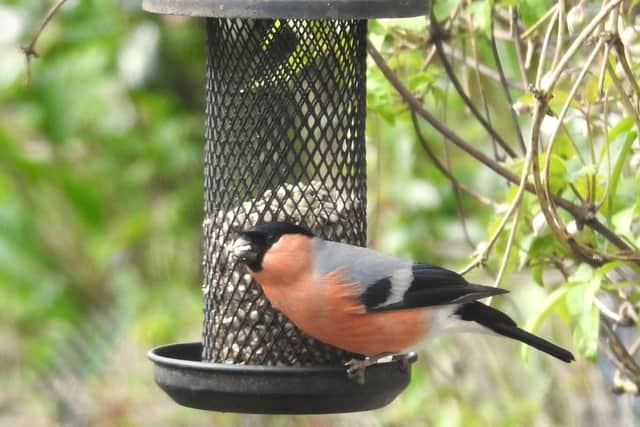On the Wildside: The bullfinches are considered to be a symbol of good luck
and live on Freeview channel 276
The scientific name includes the Latin word ‘pyrrhula’ derived from the Greek meaning ‘flame-coloured bird’. Finches are typically thick-billed, but bullfinches especially so. These heavily-built birds are plump and quite bull-necked, and both male and female have stout grey-black bills, black wings, nape, crown, and chin, with white rump, under-tail coverts and wing-bar. These white markings, particularly the rump, are very striking when they fly. The other characteristic of the bullfinch is its soft, ‘heu’ call, often delivered in flight. This is also described as a quiet, low, melancholic whistled ‘peeu’ or ‘pew’.
Indeed, this is something you hear often well before you actually spot the birds. Often described as ‘mournful’, their song does contain fluted whistles, but is heard only when at close range. Indeed, rarely heard, it is a weak, scratchy warbling, with alternating soft whistles. Though apparently, tamed bullfinches can be taught to repeat particular melodies.
Advertisement
Hide AdAdvertisement
Hide AdThese are delightful little birds, very distinctive, and considered to be a symbol of good luck for example, by the Japanese. This is marked by the Uso-Kae January festival where people come together to exchange wooden ‘bullfinches’ to bring good luck in the year to come. The exchange of the wooden birds implies the swapping of bad luck for good. For fruit-growers however, they are seen as a problem species as their favourite food consists of seeds and buds. For just a few weeks in the summer whilst feeding their young, the bullfinches do take insects as well, but otherwise the diet is fruit, seeds, buds and the like.


Probably associated with intensive farming methods, bullfinch numbers have generally fallen (perhaps by more than forty percent since the 1960s) although some readers report good numbers in their areas. With the declines in mind, the regular visits to my bird-feeders by a stunning pair of bullfinches has been very welcome. Hopefully they will breed locally.
Professor Ian D. Rotherham, researcher, writer & broadcaster on wildlife & environmental issues, is contactable on [email protected]; follow Ian’s blog (https://ianswalkonthewildside.wordpress.com/) and Twitter @IanThewildside